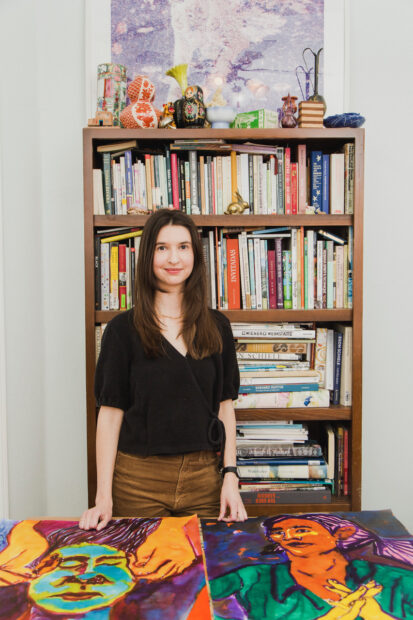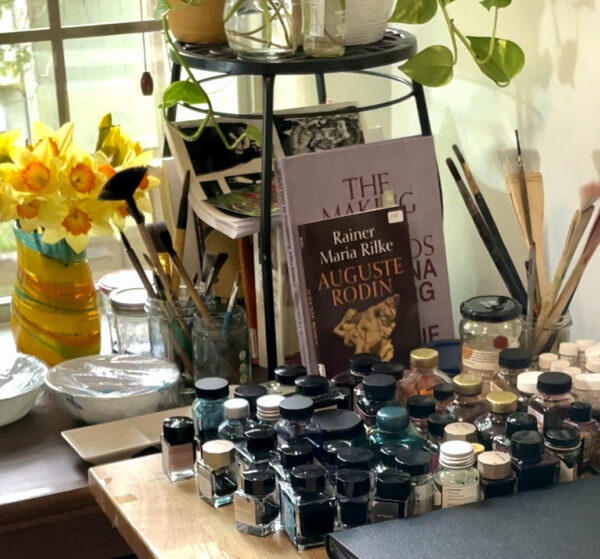There are as many books as there are paints in Lauren Moya Ford’s home studio in Austin, so it comes as no surprise that the artist — who is also a writer — paints with writer’s ink. She buys online in small batches from companies around the world; one uses a recipe dating back to the Middle Ages. Another contains a glimmer of glitter. All of them produce unusually strong color.
“Sometimes they’ll say ‘Only Use For Ink Writing,’ she tells me. “But I’m a great customer because of course I go through them much more quickly.”
On the day of my visit, bottled inks are displayed like a perfume collection near a window. Jars of brushes mimic a bouquet of flowers on the sill. A book about Auguste Rodin by Rainer Maria Rilke rests against a stool where several plants sit in the sunlight. Moya Ford’s studio is a living still life.
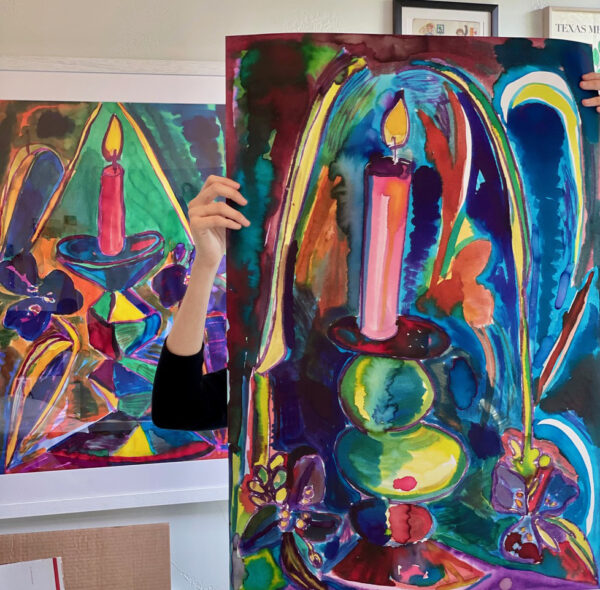
Lauren Moya Ford’s “Spiderwort Candle I” (2023) (left) and “Spiderwort Candle II” (2023) (right), ink on Masa paper. Photo: Barbara Purcell.
Across the way, a tall bookcase houses an omnium gatherum of ideas: art tomes, Japanese literature, a field guide to the wildflowers of Texas. A little bit of everything seems to inform her work, both as an artist and writer. Writing about artists is a bit of a disappearing act, she states, with no trace of herself in the words meant for others. Recently, however, Moya Ford has decided to reappear:
“My writing has been related to art, and that’s wonderful — going to museums and galleries and talking to other artists, asking them the kind of questions that I might ask myself — but I realized I was spending so much time writing about other people’s amazing blooming studio practices at the detriment to my own.”
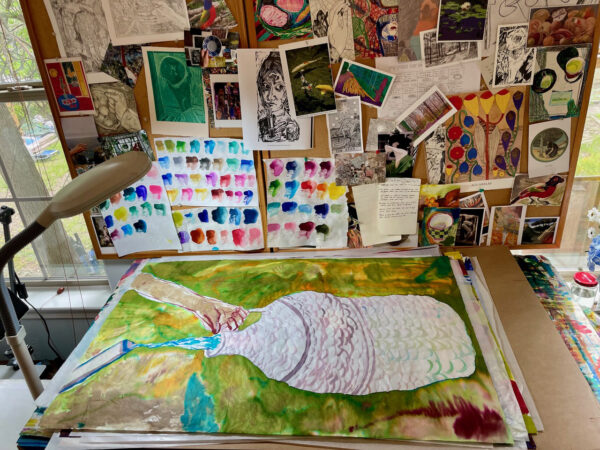
Lauren Moya Ford’s work area and “Agua de Burela,” 2022, ink on Unryu paper, 24 x 39 inches. Photo. Barbara Purcell.
Late last year, she began working on a series of poster-sized paintings — churning out up to four a day — which is a very good thing since her work is in no less than five museum and gallery shows from spring through December. In a way, putting down her pen (literally — she writes every article first by hand) and getting back into the studio has been a retroactive process. In 2019, she began freelancing full-time as an art writer for numerous publications, including Glasstire; then six months into the pandemic, she returned to Austin from living abroad and settled into an even sturdier writer’s groove. But before all that, Moya Ford received an MFA in Painting from the University of Houston; and prior to that, she majored in Studio Art (Spanish, too) as an undergrad at UT Austin.
After grad school, Moya Ford moved to Spain in 2015 for a teaching job in the city of Vigo in Galicia, the country’s northwest region bordering Portugal. Galicia is a mystical place, she tells me, with its rainy climate, forests, and quiet coastline. It’s where she first started writing, covering the local contemporary art scene in her blog Vigo Expo. Eventually she moved to Madrid, but her time in Galicia seems to have left the deeper mark, with its dreamy proximity to beauty and nature, beginning and ending with a ferry commute across the city’s shimmering estuary each day.
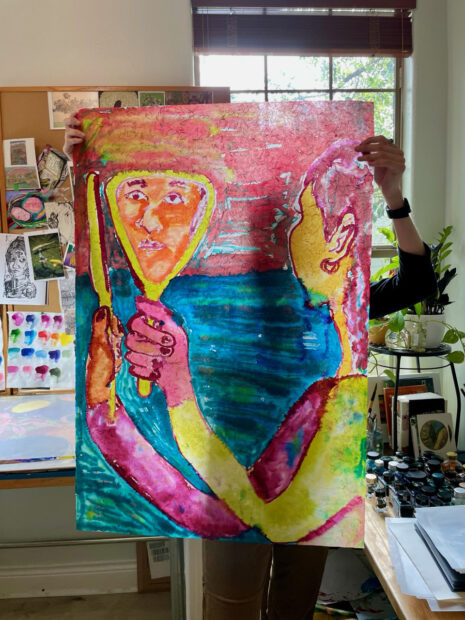
Lauren Moya Ford holding up “The Mirror and The Sea,” 2023, ink on Kinwashi paper, 25 x 37 inches. Photo: Barbara Purcell.
Spain has always loomed large for Moya Ford; her mother spent part of her childhood in Madrid after the family relocated from Texas in the 1950s and 60s. (Moya Ford’s grandfather, a native Spanish speaker from the Rio Grande Valley, was hired as a translator for the U.S. embassy after serving in World War II.) Stories from another lifetime trickled down to Moya Ford, and so she went in search of a way to belong to her family’s own history in the city. She recounts this while smoothing out a silk scarf on her work table, bought by her grandmother all those years ago, adorned with various images of Madrid: red carnations, ladies in traditional dress, a small chapel famed for its Goya frescoes.
We start sifting through her paintings and she pulls Agua de Burela (2022) from the pile, which features a handheld jug catching fresh water from a spout. That pipe, she tells me, comes straight out of a hillside in the tiny Galician town for which the painting is named. Later, we go through her earliest artist book, Passage, produced in 2016, which pairs her photography and poetry from that first year in Spain, including a picture of the same drinking spout: “I tend to revisit images that feel particularly potent.”
Figures and nature appear early and often in Moya Ford’s paintings — colorful as a cathedral’s stained glass — as well as bright-burning candles and hands in various states of prayer. “I don’t think I would have been an artist if I hadn’t been raised Catholic,” she reflects. “The visual culture of Catholicism is so rich, everything carries so much meaning.”
Her female characters often maintain an element of ambiguity, perhaps to avert autobiography: women in veils and women holding vanity mirrors. Some wearing folkloric costumes and others wearing nothing at all, instead soaking in a body of water. Small objects often accompany these figures, their symbolic placement within the compositions reminiscent of a holy card, or a tarot card.
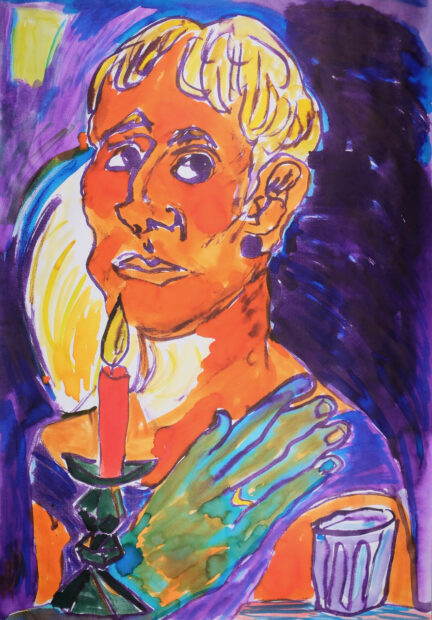
Lauren Moya Ford, “Woman with Candle (after Beckmann),” 2023, ink on Masa paper, 21 x 31 inches. Photo courtesy the artist.
Moya Ford’s drawings and paintings (and ceramics and prints) all flow from the same spout: there is as much a stylistic nod to Japanese woodblock prints as to poetry, Catholic imagery, and Western art history. She mentions the Scottish floral painter Elizabeth Blackladder in the same breath as the German Expressionists, pointing to a printout of Max Beckmann’s black-and-white Woman with Candle (1920) pinned to the center of her busy cork board. Her own version (which credits Beckmann in the title) is a vibrant painting that explodes with orange and purple, channeling the immediacy and intensity of the original woodcut’s strong lines.
She holds up another recent painting of hers, a woman gazing at herself with a mirror in each hand; early afternoon light pours through the painting as if it were a silk scarf. Kinwashi is one of several types of Japanese art paper she’s used in this series; its sheer quality could just as easily billow from a clothesline as hang on a wall. Each type of paper has its own texture and transparency — and element of uncertainty, it turns out — of how colors and lines will collide.
“When I’m painting I’m not coming at it with a clear plan,” she shrugs. “Little accidents happen and it can get out of hand.” Lines go washy and dry just as fast along the paper’s fibers. Forms get blotchy, tones get muffled. Ink might simply sit on the surface or soak all the way through, until the image and material are one.
This looseness, frankly, is the opposite of Moya Ford’s writing, where each article is a careful investigation of the subject at hand. But there is an elegance both to her imprecision and clear precision. As well as a delicate balance: “I’ve struggled with people knowing me as a writer more than an artist. Even though I’ve been an artist longer.”
So says the artist who paints with writer’s ink.
For information on upcoming exhibitions, visit the artist’s website.


